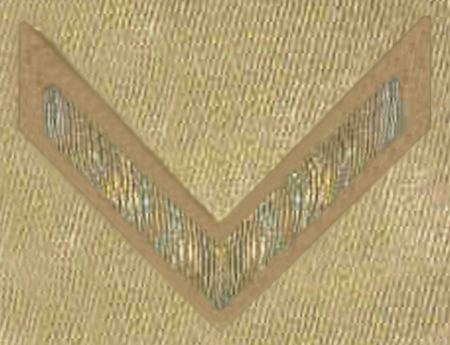 | ||
A Wound Chevron was a badge of the United States Army, United States Navy and United States Marine Corps which was authorized for wear on uniforms between the years of 1918 and 1932. The Wound Chevron was a gold metallic-thread chevron on an Olive Drab backing displayed on the lower right cuff of a US military uniform. It denoted wounds which were received in combat against an enemy force or hospitalization following a gassing. Initially created for the Army, Navy and Marine Corps personnel who had been wounded in combat could also receive it. The Wound Chevron was a replacement insignia for the short lived Army Wound Ribbon of 1917.
In 1932, with the creation of the Purple Heart, Wound Chevrons were no longer awarded. A directive of the United States War Department and United States Navy Department]] permitted soldiers to exchange wound chevrons for the new Purple Heart medal. This was not required, however, and some Army personnel elected to retain wound chevrons for wear on their uniforms instead of the Purple Heart. For those who were subsequently wounded, both the original wound chevrons and the Purple Heart medal were worn simultaneously. It is historically agreed that regulations did not permit wearing both the Purple Heart and the Wound Chevron at the same time; however, photographic evidence indicates that this was often done by veterans of both the First World War and Second World War. Its wear on the uniform was abolished in 1953, as the Overseas Service Bars were moved there.
In the modern military, the Wound Chevron is considered obsolete. The decoration is very similar to the Overseas Chevron, which in World War I was worn on the left sleeve.
